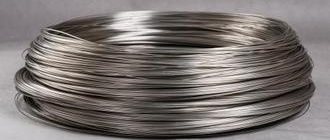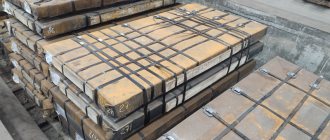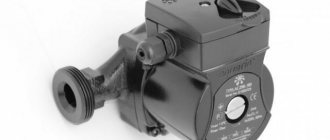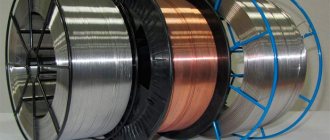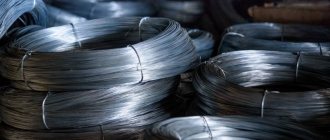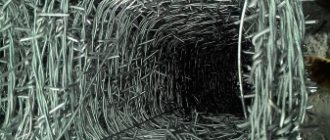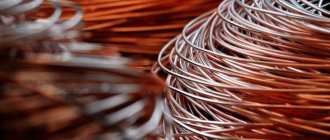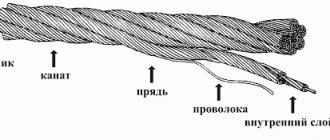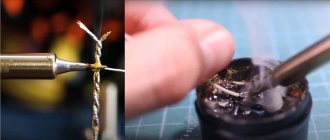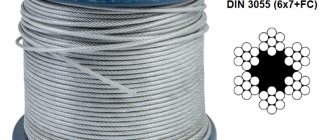Steel wire is a long metal thread having a round, square, hexagonal or trapezoidal cross-section. The materials used to make wire are aluminum, zinc, steel, copper and alloys of these metals; it can also be bimetallic or polymetallic. These products vary, including in diameter. It can be equal to two millimeters, but can reach several centimeters. Wire is indispensable for the manufacture of springs and drills, electrodes and hardware, wires and devices, as well as various mechanisms.
One of the methods for making wire is drawing. That is, the workpieces are pulled through holes that decrease sequentially.
Wire can be heat-treated or untreated, that is, it differs in the processing method. Heat treated is also called knitting. Knitting wire serves as a semi-finished product for cables, wires, ropes and springs. It is used, among other things, for making nails and tying parts of fencing.
The surface of the wire can be coated with a polymer coating, galvanized, or not have any coating. Galvanized samples are passed through a mass of molten zinc. With this measure, the wire becomes stronger, more reliable and lasts much longer. When marking, low-carbon wire without coating is designated by the letters “KS”. It performs the function of a current-carrying core in various cables and is part of mechanism components.
Scope, purpose
Copper-plated wire is used for welding low-carbon and low-alloy steels . It is made from similar materials. The ability to easily deform and obtain the required standard sizes is the distinctive properties of these metals. By broaching (drawing) material calibrated in diameter is produced from rolled blanks.
Copper-coated wire SV-08G2S-O KEDR, cassette 15 kg. Photo VseInstruments.ru
The main purpose, after coating with copper, is to use it in semi-automatic welding machines as a filler wire. Since this consumable does not contain components to protect the weld seam, welding is performed in carbon dioxide or a mixture of carbon dioxide and argon. Therefore, copper-clad wire is a popular material option for TIG welding.
Video
How it is made.
Production specifics
Wire was known several thousand years ago. In Ancient Egypt, the material was made from soft gold. Later, the production process was improved many times, and steel or special-purpose alloys began to be used as raw materials.
General type steel wire must comply with GOST 3282-74. Manufacturing is carried out in accordance with the requirements of GOST 1050-74 or GOST 4231-70. The cross-section diameter can be 0.16-10 mm (uncoated) and 0.2-6 mm (coated). Based on the purpose of the material, the production cycle includes several operations:
- cleaning the workpiece using chemically active substances, i.e. pickling;
- washing the material with cold water, drying, coating with drawing lubricant;
- drawing using the selected technological method;
- temperature treatment, normalization and stabilization of the product;
- surface treatment, including the application of protective coatings;
- winding, fixing skeins.
Since steel is susceptible to corrosion, to extend its service life the metal is coated with protective compounds and methods of galvanization and thermal hardening are used. This makes the wire one of the most wear-resistant, functional, and easy-to-use products.
Designation and marking
Domestic copper-plated welding wire must comply with GOST 2246-70. An example of a designation according to this document: wire 1.2 SV08G2S-O GOST 2246-70 , where the sign “O” indicates the surface is coated with copper.
Copper-plated welding wire ER70S-6 (1 mm; 15 kg) ELKRAFT. Photo VseInstruments.ru
Filler materials supplied by foreign manufacturers must comply with the AWS (American Welding Society) . Example: ER70S-6, corresponds to SV08G2S-O.
Features of copper-clad wire
Copper-clad wire has an aesthetic appearance, but that is not why it is valued. One of its main characteristics is low contact resistance, which means better current supply. In this indicator, copper-plated wire differs from the standard analogue, coated with technological lubricant, by approximately 100 times. Low contact resistance, in addition to stable arc combustion, causes weak spattering of the electrode metal during welding.
The condition of the surface has a direct impact on the uniformity of wire feeding and the force required for this. For example, wire without copper coating is characterized by unstable feeding, high abrasive wear of the current-carrying tip and sticking to the inner surface of its channel. At the same time, technological lubrication is the reason for the increase in the number of such tacks. Copper-clad wire requires less force to push and does not contribute to rapid wear of the tip bore. It is supplied in reels or cassettes and in the form of an orderly and tightly wound series. This ensures continuity and uniformity of its supply.
Semi-automatic welding torch
Another undoubted advantage of copper-plated wire is the minimum amount of impurities harmful to the welding seam. Its counterpart without copper coating is an active supplier of hydrogen. The culprit of this situation is the same technological lubricant. It contains fatty acids, alkalis and water. In addition, it is able to adsorb moisture from the air. As a result, the process of wire corrosion accelerates, and hydrogen enters the seams, causing them to become porous.
Copper-clad wire reduces the time from the first contact with the metal surface to stable arc burning by 2-3 times compared to non-copper-clad wire. It promotes the formation of symmetrical and equal-sized drops of metal at the end of the electrode and their uniform transfer into the weld pool. As a result, the quality of seams improves and spattering is reduced by approximately 40%.
Additionally, it should be noted that thanks to the copper coating, it is possible to improve the characteristics of welds. Their resistance to tearing or impact loads increases, their ability to withstand temperature changes improves, and the number of defects decreases. In addition, the smooth coating increases wire feed speed and productivity.
Copper is used for more than just metal welding. It is used to cover surgical scalpels. In this case, copper provides electricity to heat the blade. As a result, scalpels are simultaneously used for cauterization during operations.
Popular brands
The following types and brands of copper-plated welding wires are most widespread on the domestic market: low-carbon Sv-08-O; Sv-08A-O and low-alloy Sv-08G2S-O; Sv-08GA-O; Sv-08GS-O; Sv-08ХМ-О.
Reference. Wire grade PANCH-11 (for cast iron) ensures high-quality results when working with materials that are difficult to weld.
Various foreign companies supply copper-clad wire under the designation ER70S-6.
Copper-plated welding wire for submerged arc welding DEKA EM 12 (analogous to Sv08GA-O) 4.0 mm. (25 kg). Photo by DEKA
BEATING THE WIRE
There are several ways to harden the wire: tumbling with steel shot, hammering, hitting a steel block/anvil with a rubber mallet, twisting the wire, pulling it through rollers or even through a polishing cloth. Even simply working with the wire and the process of winding and twisting it also strengthens it a little. The softer the wire, the more reinforcement will be required for the wire to hold its shape.
Characteristics
The chemical composition of copper-plated welding wire Sv-08G2S-O is as follows:
- carbon – 0.06%;
- manganese – 1.8%;
- silicon – 0.88%;
- sulfur – 0.012%;
- phosphorus – 0.010.
The mechanical characteristics of the weld depend on the shielding gas used during welding. The tensile strength in a protective environment of carbon dioxide is 540 MPa, in a gas mixture of 80% Argon and 20% carbon dioxide – 550 MPa.
For Sv-08G2S-O wire used as a filler material, the deposition coefficient is important. The higher it is, the more options there are for the use of filler material in welding technologies.
Types of products
Stiltekhsnab LLC produces various types of products presented. This list includes the following wires:
- knitting - a general-purpose material used to create reinforcement and increase the strength of concrete;
- rope - used for weaving into reliable ropes that can withstand multi-ton loads;
- spring - made by cold winding, used to create springs of various diameters;
- VR-1 – produced from low-carbon steel for installation of reinforcing mesh and reinforcing structures.
There is a division of products by diameter, i.e. a conventional circle describing the shape of the section. The criterion becomes key when identifying the minimum tensile load. It also depends on the brand of material, production technology, and the presence of protective compounds. Depending on the diameter of the steel wire, 9 product classes (1-9) are distinguished. The first class is the least resistant to tearing, and its diameter is up to 0.1 mm. The most durable is considered class 9 with a diameter of over 8 mm.
Distinctive features, advantages and disadvantages
Copper-plated steel welding wire exhibits its best qualities when used on semi-automatic machines instead of bare wire. Copper, having good conductivity, significantly improves the current supply to the welding zone . This stabilizes the arc ; the molten droplets of the consumable are of the same size along the entire length of the weld. There is virtually no metal spattering , thereby reducing the consumption of welding wire.
ESAB OK Autrod 12.64 is a solid copper-plated wire alloyed with 1.7% Mn, used for semi-automatic welding of carbon and low-alloy steels. Photo Welding Technologies
In semi-automatic machines, the wire is fed into the welding zone through a special tip. Conventional uncoated wire, together with residual process lubricant on its surface, quickly wears out the inner diameter of the tip. The copper-coated wire makes sliding much easier. This increases the service life of the equipment before carrying out maintenance work. The uniformity of the arc feed into the working zone of copper-plated wire is much higher.
Copper-coated wire is more resistant to corrosion than uncoated wire, despite small cracks and pores in the copper layer. It is stored longer, but the requirements for humidity and room temperature must be met.
The absence of additional resistance to the supply of welding current (for copper-coated wire) makes it possible to reduce the time to ensure stable arc burning from the start of work (touching the workpieces being welded with the wire).
Reference. Titanium wires have a wide range of distinctive characteristics, in particular the most “clean” grade of materials VT1-00Sv.
The presence of copper, especially its increased amount, can lead to the formation of cracks in the weld and a decrease in the impact strength value. In the aviation industry, for example, where there is a large proportion of highly critical welding joints, the use of copper-clad wire is permitted only with the permission of the chief technical specialists. The total copper content is limited by GOST 2246-70. It should not exceed 0.25%. This is achieved with a coating layer thickness of up to 6 microns.
Scope of application
The use of steel wire has reached global proportions. The product is found everywhere, and in many cases without it it is impossible to achieve the goals set in various areas of human life. Here are common practices for using the products presented:
- ropes and cables – provide lifting work in construction, aviation, shipping, heavy or light industry;
- protective structures - many fencing elements (nets, fences, etc.) are made of steel wire;
- tying of reinforcement – guarantees the strength characteristics of load-bearing and non-load-bearing objects;
- welding products - used together with electrodes and rods to connect products with a high level of expected load.
An unusual area of application for the products described are various musical instruments. The strings of violins, cellos, pianos, and other similar products are made of steel wire. The material combines practical and aesthetic functions.
Requirements
There should be no defects on the surface . The only thing that is allowed is the risks from wire drawing during its manufacture. In this case, the number of marks is limited to 5% of the total surface .
Fubag copper-plated welding wire. Photo 220Volt
Strict requirements are imposed on winding. The row and density of winding in the coils is an important condition for its uniform supply when performing welding work.
WHAT TO CHOOSE FOR BEGINNERS
While in many cases the hardness of jewelry wire is a personal preference and varies from project to project, if you're just learning, the most versatile option is the medium-hard option.
This option will allow you to try different techniques and bring your ideas to life in any situation, because... you can always strengthen the wire or use a different size to achieve the desired stiffness. The thinner the wire, the softer it feels when working.
Later you can choose a more convenient option for you, explore the capabilities of each wire, but in the early stages it is better to invest in different sizes of wire.
Our wire can be purchased via this link.
Assortment
The choice of welding mode is influenced by the size of the welding wire. Diameters most often used during work: 0.8 mm; 1.0 mm; 1.2 mm; 1.6 mm; 2.0 mm. In some branches of mechanical engineering, filler materials up to 6.0 mm are used.
Copper-plated steel welding wire (1 kg; diameter 0.8 mm) Elitech. Photo VseInstruments.ru
Manufacturers
Swedish ]ESAB[/anchor] in its range of produced welding consumables has a line of standard sizes of copper-plated wire: alloyed OK Autrod 12.64; OK Autrod 12.51 and others. It has strict requirements for the geometry and strength of the copper coating. Copper shavings do not accumulate in the feed tip.
Reference. Welders owe the creation of polished wire to a Swedish company.
Chinese manufacturers Prima, DEKA and Golden Bridge produce copper-plated wire that meets the stringent requirements of European standards. However, compared to Western companies, their products are economically advantageous for widespread use by customers, so welders also purchase other types of products, for example, stainless, aluminum and flux (powder).
Criterias of choice
The quality of steel wire is determined by the production technology and the metal from which it is made. Minor variations in composition dramatically affect the performance characteristics of the product. When selecting products, you should pay attention to the following criteria:
- diameter (the larger it is, the stronger the wire);
- type of coating – the presence of a protective composition will extend the service life of the product;
- relative tensile elongation - shows the tensile strength of the composition;
- electrical resistance - reflects the ability of a material to conduct current.
The number of kinks deserves special attention. The criterion shows how many bends a steel wire will withstand in one place before it breaks (breaks). For example, for a spring type this number usually varies between 4-6, and for knitting analogues it reaches 10-16. With high rigidity of the material, the number of kinks decreases, therefore, it is less flexible.
Stiltekhsnab LLC sells a wide range of steel wire on favorable terms. In the production process, only high-quality raw materials, modern equipment and advanced technologies are used. This allows you to obtain durable, practical products that fully comply with the declared characteristics. We value our impeccable reputation, so we always take into account the constructive requirements of our clients and provide a high level of service.
